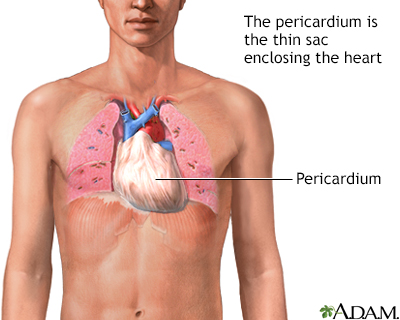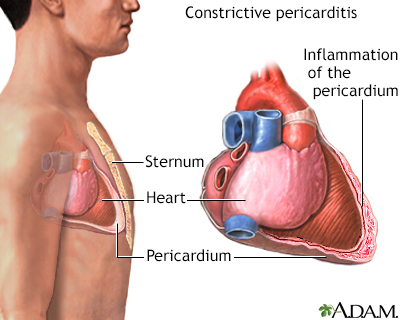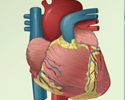Pericarditis - constrictive
Constrictive pericarditis is a process in which the sac-like covering of the heart (the pericardium) becomes thickened and scarred.
Related conditions include:
- Bacterial pericarditis
- Pericarditis
Pericarditis
Pericarditis is a condition in which the sac-like covering around the heart (pericardium) becomes inflamed.
 ImageRead Article Now Book Mark Article
ImageRead Article Now Book Mark Article - Pericarditis after heart attack
Pericarditis after heart attack
Pericarditis is inflammation and swelling of the covering of the heart (pericardium). It can occur in the days or weeks following a heart attack....
 ImageRead Article Now Book Mark Article
ImageRead Article Now Book Mark Article

Pericardium
The pericardium is a thin double-layered sac which encloses the heart. Fluid is contained within the layers and lubricates the constantly rubbing surfaces.
Causes
Most of the time, constrictive pericarditis occurs due to things that cause inflammation to develop around the heart, such as:
- Heart surgery
- Radiation therapy to the chest
Radiation therapy
Radiation therapy uses high-powered radiation (such as x-rays or gamma rays), particles, or radioactive seeds to kill cancer cells.
 ImageRead Article Now Book Mark Article
ImageRead Article Now Book Mark Article - Tuberculosis
Tuberculosis
Pulmonary tuberculosis (TB) is a contagious bacterial infection that involves the lungs. It may spread to other organs.
 ImageRead Article Now Book Mark Article
ImageRead Article Now Book Mark Article
Less common causes include:
- Abnormal fluid buildup in the covering of the heart. This may occur because of infection or as a complication of surgery.
- Mesothelioma
Mesothelioma
Malignant mesothelioma is an uncommon cancerous tumor. It mainly affects the lining of the lung and chest cavity (pleura) or lining of the abdomen (...
 ImageRead Article Now Book Mark Article
ImageRead Article Now Book Mark Article
The condition may also develop without a clear cause.
It is rare in children.

Constrictive pericarditis
Constrictive pericarditis is a disorder caused by inflammation of the pericardium, the sac-like covering of the heart. Eventual thickening, scarring and contracture of the pericardium occurs causing it to be less elastic. This prevents the pericardium from stretching and results in reduced filling of the chambers of the heart. This reduces the amount of blood pumped by the heart and causes blood to back up behind the heart, resulting in symptoms of heart failure. Constrictive pericarditis may be life threatening if untreated.
Symptoms
When you have constrictive pericarditis, the inflammation causes the covering of the heart to become thick and rigid. This makes it hard for the heart to expand properly when it beats. As a result, the heart chambers don't fill up with enough blood. Blood backs up behind the heart, causing heart swelling and other symptoms of heart failure.
Symptoms of chronic constrictive pericarditis include:
- Difficulty breathing (dyspnea) that develops slowly and gets worse
Dyspnea
Breathing difficulty may involve:Difficult breathing Uncomfortable breathingFeeling like you are not getting enough air
 ImageRead Article Now Book Mark Article
ImageRead Article Now Book Mark Article - Fatigue
Fatigue
Fatigue is a feeling of weariness, tiredness, or lack of energy.
 ImageRead Article Now Book Mark Article
ImageRead Article Now Book Mark Article - Long-term swelling (edema) of the legs and ankles
Edema
Swelling is the enlargement of organs, skin, or other body parts. It is caused by a buildup of fluid in the tissues. The extra fluid can lead to a ...
 ImageRead Article Now Book Mark Article
ImageRead Article Now Book Mark Article - Swollen abdomen
Swollen abdomen
A swollen abdomen is when your belly area is bigger than usual.
 ImageRead Article Now Book Mark Article
ImageRead Article Now Book Mark Article - Weakness
Exams and Tests
Constrictive pericarditis is very hard to diagnose. Signs and symptoms are similar to other conditions such as restrictive cardiomyopathy and cardiac tamponade. Your health care provider will need to rule out these conditions when making a diagnosis.
Restrictive cardiomyopathy
Restrictive cardiomyopathy refers to a set of changes in how the heart muscle functions. These changes cause the heart to fill poorly (more common) ...

Cardiac tamponade
Cardiac tamponade is pressure on the heart that occurs when blood or fluid builds up in the space between the heart muscle and the outer covering sac...

A physical exam may show that your neck veins stick out. This indicates increased pressure around the heart. The provider may note weak or distant heart sounds when listening to your chest with a stethoscope. A knocking sound may also be heard.
The physical exam may also reveal liver swelling and fluid in the belly area.
The following tests may be ordered:
- Chest MRI
Chest MRI
A chest MRI (magnetic resonance imaging) scan is an imaging test that uses powerful magnetic fields and radio waves to create pictures of the chest (...
 ImageRead Article Now Book Mark Article
ImageRead Article Now Book Mark Article - Chest CT scan
Chest CT scan
A chest CT (computed tomography) scan is an imaging method that uses x-rays to create cross-sectional pictures of the chest and upper abdomen....
 ImageRead Article Now Book Mark Article
ImageRead Article Now Book Mark Article - Chest x-ray
Chest x-ray
A chest x-ray is an x-ray of the chest, lungs, heart, large arteries, ribs, and diaphragm.
 ImageRead Article Now Book Mark Article
ImageRead Article Now Book Mark Article - Coronary angiography or cardiac catheterization
Coronary angiography
Coronary angiography is a procedure that uses a special dye (contrast material) and x-rays to see how blood flows through the arteries in your heart....
 ImageRead Article Now Book Mark Article
ImageRead Article Now Book Mark Article - ECG
ECG
An electrocardiogram (ECG) is a test that records the electrical activity of the heart.
 ImageRead Article Now Book Mark Article
ImageRead Article Now Book Mark Article - Echocardiogram
Echocardiogram
An echocardiogram is a test that uses sound waves to create pictures of the heart. The picture and information it produces is more detailed than a s...
 ImageRead Article Now Book Mark Article
ImageRead Article Now Book Mark Article
Treatment
The goal of treatment is to improve heart function. The cause must be identified and treated. Depending on the source of the problem, treatment may include anti-inflammatory agents, antibiotics, medicines for tuberculosis, or other treatments.
Diuretics ("water pills") are often used in small doses to help the body remove excess fluid. Pain medicines may be needed for discomfort.
Some people may need to cut down on their activity. A low-sodium diet may also be recommended.
If other methods do not control the problem, surgery called a pericardiectomy may be needed. This involves cutting or removing the scarring and part of the sac-like covering of the heart.
Outlook (Prognosis)
Constrictive pericarditis may be life threatening if untreated.
However, surgery to treat the condition has a high risk for complications. For this reason, it is most often done in people who have severe symptoms.
Possible Complications
Complications may include:
- Heart failure
Heart failure
Heart failure is a condition in which the heart is no longer able to pump oxygen-rich blood to the rest of the body efficiently. This causes symptom...
 ImageRead Article Now Book Mark Article
ImageRead Article Now Book Mark Article - Pulmonary edema
Pulmonary edema
Pulmonary edema is an abnormal buildup of fluid in the lungs. This buildup of fluid leads to shortness of breath.
 ImageRead Article Now Book Mark Article
ImageRead Article Now Book Mark Article - Liver and kidney dysfunction
- Scarring of the heart muscle
When to Contact a Medical Professional
Contact your provider if you have symptoms of constrictive pericarditis.
Prevention
In some cases, constrictive pericarditis is not preventable.
However, conditions that can lead to constrictive pericarditis should be properly treated.
Reviewed By
Thomas S. Metkus, MD, Assistant Professor of Medicine and Surgery, Johns Hopkins University School of Medicine, Baltimore, MD. Also reviewed by David C. Dugdale, MD, Medical Director, Brenda Conaway, Editorial Director, and the A.D.A.M. Editorial team.
Hoit BD, Oh JK. Pericardial diseases. In: Goldman L, Cooney KA, eds. Goldman-Cecil Medicine. 27th ed. Philadelphia, PA: Elsevier; 2024:chap 62.
Jouriles NJ. Pericardial and myocardial disease. In: Walls RM, Hockberger RS, Gausche-Hill M, eds. Rosen's Emergency Medicine: Concepts and Clinical Practice. 10th ed. Philadelphia, PA: Elsevier; 2023:chap 68.
Lewinter MM, Cremer PC, Klein AL. Pericardial diseases. In: Libby P, Bonow RO, Mann DL, Tomaselli GF, Bhatt DL, Solomon SD, eds. Braunwald's Heart Disease: A Textbook of Cardiovascular Medicine. 12th ed. Philadelphia, PA: Elsevier; 2022:chap 86.

 All rights reserved.
All rights reserved.